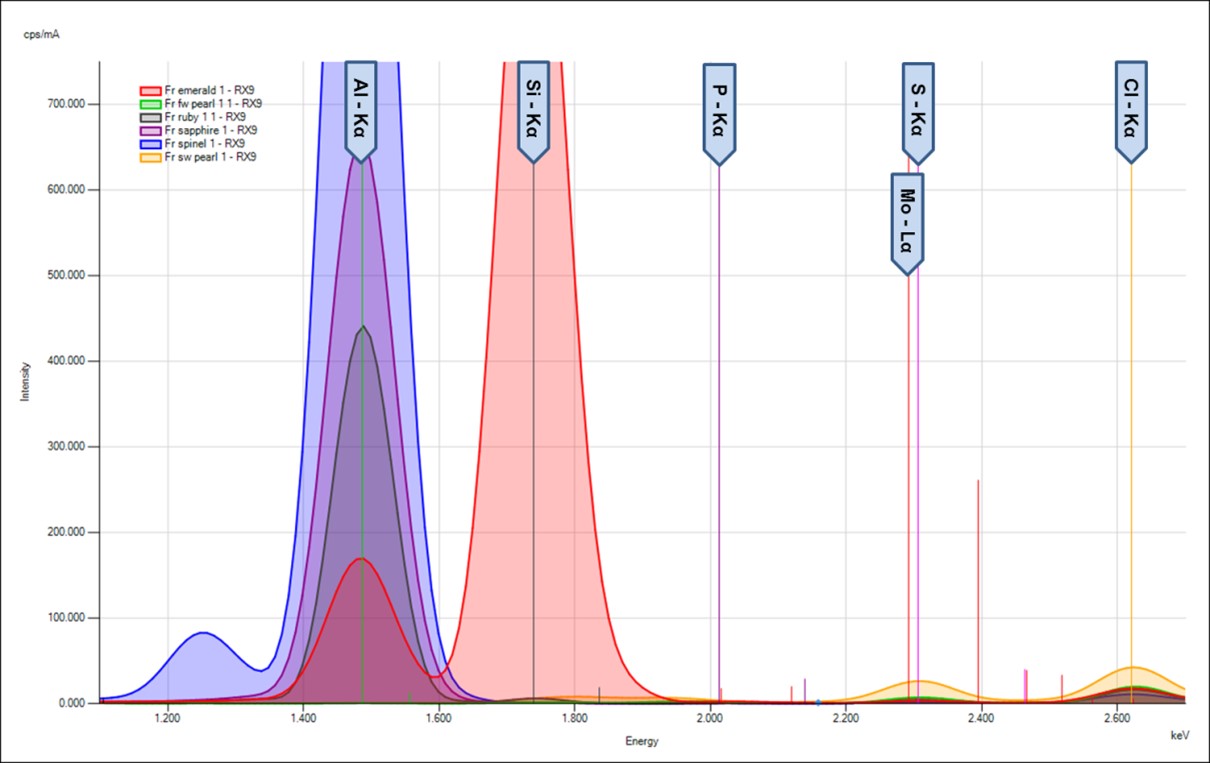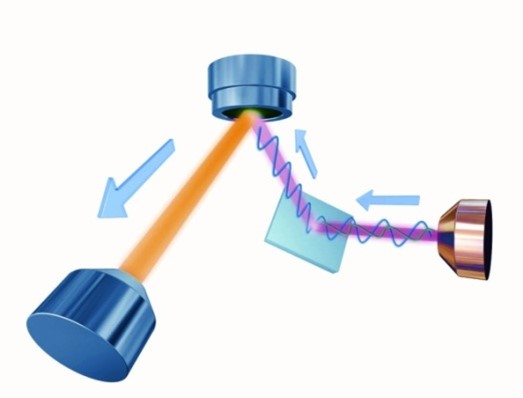Application Note EDXRF1241
Scope
The analysis of gemstones is demonstrated, using low power 50W EDXRF with indirect excitation.
Background
 Elemental measurement is important in gemology for identification, classification and characterization of both natural and synthetic gemstones. Minor and trace levels of metals, especially the transition metals, as well as alkali elements and alkaline earth elements (such as Mg, K, Ca, Sr and Rb) help to establish the geographic region and environmental conditions during the formation of a gemstone. Other elements like Au and Pb can be used to indicate processing requirements of synthetics.
Elemental measurement is important in gemology for identification, classification and characterization of both natural and synthetic gemstones. Minor and trace levels of metals, especially the transition metals, as well as alkali elements and alkaline earth elements (such as Mg, K, Ca, Sr and Rb) help to establish the geographic region and environmental conditions during the formation of a gemstone. Other elements like Au and Pb can be used to indicate processing requirements of synthetics.
EDXRF (Energy dispersive X-ray Fluorescence) is a simple, non-contact, non-destructive analysis technique that is ideal for use in precious materials testing. The technique can be used for qualitative screening or gemstone characterization by elemental quantification. EDXRF is useful in quantifying the elements that occur in many gem materials, as well as other elements that are evidence of certain treatment processes. The benefit of using low power 50W EDXRF is that the X-ray source will not damage the gems. Secondary targets and polarization also make the analysis simple by eliminating most if not all of the extraneous background scatter X-rays.
 Model: NEX CG
Model: NEX CG
Rigaku RPF-SQX Fundamental Parameters (FP)
A Fundamental Parameters (FP) method was developed from Rigaku’s RPF-SQX Metals Template. The RPF-SQX method uses an advanced FP program that automatically deconvolutes spectral peaks and models the sample matrix using fundamental XRF equations. This provides an estimate of the percentage of the sample that cannot be measured and yields more accurate analytical results for the remaining elements that can be measured, affording a semi-quantitative measurement of elemental concentrations without the need for a large suite of known assayed calibration standards.
In addition, a matrix-specific Matching Library can be created using one assayed sample of each gemstone to further optimize analytical results. The Matching Library is easy to create and is employed in conjunction with the standard FP library to optimize model of each matrix so as to improve the calculation of concentration results.
The results shown here use standardless analysis and indicate excellent performance without the use of a Matching Library.
RPF-SQX Results
| SW Pearl Units: Mass% |
||
| Component | NEX CG value | Stat. error |
| Mg | 0.218 | 0.0048 |
| Al | ND** | -- |
| Si | 0.116 | 0.0013 |
| P | 0.0152 | 0.0003 |
| S | 0.153 | 0.0004 |
| Cl | 0.126 | 0.0003 |
| K | 0.0739 | 0.0020 |
| CaCO₃ | 99.06 | -- |
| Ti | ND | -- |
| V | ND | -- |
| Cr | ND | -- |
| Mn | 0.0092 | 0.0006 |
| Fe | 0.0081 | 0.0004 |
| Co | ND | -- |
| Ni | ND | -- |
| Cu | 0.0231 | 0.0004 |
| Zn | 0.0081 | 0.0002 |
| Ga | ND | -- |
| Br | 0.0012 | 0.0001 |
| Rb | ND | -- |
| Sr | 0.1817 | 0.0004 |
| Mo | ND | -- |
| Yb | ND | -- |
| Ir | ND | -- |
| Au | 0.0016 | 0.0002 |
| Hg | 0.0012 | 0.0001 |
| Tl | ND | -- |
| Pb | ND | -- |
| Spinel Units: Mass% |
||
| Component | NEX CG value | Stat. error |
| Mg | 5.69 | 0.0303 |
| Al₂O₄† | 94.21 | -- |
| Si | ND | -- |
| P | ND | -- |
| S | ND | -- |
| Cl | 0.0195 | 0.0003 |
| K | 0.0079 | 0.0011 |
| Ca | 0.0040 | 0.0007 |
| Ti | 0.0282 | 0.0007 |
| V | 0.0159 | 0.0005 |
| Cr | ND | -- |
| Mn | ND | -- |
| Fe | 0.0066 | 0.0004 |
| Co | 0.0135 | 0.0004 |
| Ni | ND | -- |
| Cu | 0.0051 | 0.0002 |
| Zn | 0.0015 | 0.0001 |
| Ga | ND | -- |
| Br | ND | -- |
| Rb | ND | -- |
| Sr | ND | -- |
| Mo | ND | -- |
| Yb | ND | -- |
| Ir | ND | -- |
| Au | ND | -- |
| Hg | 0.0002 | 0.0001 |
| Tl | ND | -- |
| Pb | ND | -- |
| Sapphire Units: Mass% |
||
| Component | NEX CG value | Stat. error |
| Mg | ND | -- |
| Al₂O₃ | 98.90 | -- |
| Si | ND | -- |
| P | ND | -- |
| S | 0.0152 | 0.0003 |
| Cl | 0.117 | 0.0004 |
| K | 0.0269 | 0.0012 |
| Ca | 0.0147 | 0.0007 |
| Ti | 0.0090 | 0.0003 |
| V | 0.0017 | 0.0002 |
| Cr | ND | -- |
| Mn | ND | -- |
| Fe | 0.823 | 0.0016 |
| Co | 0.0090 | 0.0004 |
| Ni | ND | -- |
| Cu | 0.0278 | 0.0003 |
| Zn | 0.0070 | 0.0001 |
| Ga | 0.0157 | 0.0002 |
| Br | ND | -- |
| Rb | ND | -- |
| Sr | ND | -- |
| Mo | ND | -- |
| Yb | ND | -- |
| Ir | 0.0034 | 0.0002 |
| Au | 0.0022 | 0.0001 |
| Hg | ND | -- |
| Tl | 0.0019 | 0.0001 |
| Pb | ND | -- |
| Emerald Units: Mass% |
||
| Component | NEX CG value | Stat. error |
| Be₃Al₂ | 14.75 | 0.0191 |
| Mg | ND | -- |
| SiO₃ | 84.16 | -- |
| P | 0.0337 | 0.0005 |
| S | 0.0060 | 0.0003 |
| Cl | 0.0949 | 0.0004 |
| K | 0.0328 | 0.0015 |
| Ca | 0.0158 | 0.0011 |
| Ti | 0.0007 | 0.0003 |
| V | 0.0558 | 0.0007 |
| Cr | 0.707 | 0.0018 |
| Mn | 0.0134 | 0.0010 |
| Fe | 0.0185 | 0.0004 |
| Co | ND | -- |
| Ni | 0.0018 | 0.0001 |
| Cu | 0.0182 | 0.0002 |
| Zn | 0.0046 | 0.0001 |
| Ga | 0.0015 | 0.0001 |
| Br | ND | -- |
| Rb | 0.0012 | <0.0001 |
| Sr | ND | -- |
| Mo | 0.0617 | 0.0017 |
| Yb | 0.0041 | 0.0004 |
| Ir | ND | -- |
| Au | 0.0148 | 0.0002 |
| Hg | ND | -- |
| Tl | ND | -- |
| Pb | 0.0052 | 0.0001 |
** ND means the component was not detected.
† The main component of Spinel is MgAl₂O₄; alternately, MgO and Al₂O₃ could be entered as components
Qualitative analysis
As an example of qualitative analysis, the gemstone spectra are overlaid and provided below.
 RX9 (HOPG polarizer) secondary target
RX9 (HOPG polarizer) secondary target
 Cu secondary target
Cu secondary target
 Mo secondary target
Mo secondary target
 Al secondary target
Al secondary target
Discussion
The Rigaku NEX CG energy dispersive X-ray fluorescence (EDXRF) spectrometer combines indirect excitation with secondary targets, polarization targets and a high performance SDD to give the operator a powerful and versatile analysis tool with a very simple to operate software interface. In contrast to conventional EDXRF systems, indirect excitation removes virtually all the background and thus affords spectra with a very high characteristic signal-to-noise ratio. This allows for much lower detection limits and a higher degree of accuracy.
 Secondary target schematic
Secondary target schematic
The spectra and quantitative results shown above indicate NEX CG can be used an important tool in the characterization of gemstones. When a gem is known, the analysis method can be optimized by defining the gem’s major component as the balance of the matrix. Example of this is Al₂O₃ as the major component of sapphire, the CaCO₃ of pearl and the Be₃Al₂ of emerald. Information about synthetics and processing can be determined in part by the presence of trace Au and/or Pb, indications of the processing crucible used. Other identifiers may lie in certain elemental ratios, such as the Sr/Mn ratio in fresh water and sea water pearls.
| Pearl Type | Sr/Mn Ratio |
| Fresh Water Pearl 1 | 0.658 |
| Fresh Water Pearl 2 | 0.404 |
| Sea Water Pearl | 19.75 |
Conclusion
The Rigaku NEX CG using the RPF-SQX Fundamental Parameters method yields excellent performance for the elemental analysis of gemstones. Indirect excitation and polarization give the gemologist an excellent low background tool, and low 50W power ensures no damage to the gemstone during analysis. The use of RPF-SQX eliminates the need for calibration standards, and if desired quantification can be optimized with Matching Libraries based on one assayed sample of each gemstone. These features and more make the NEX CG an ideal EDXRF tool for the elemental identification and characterization of gemstones and similar materials.

